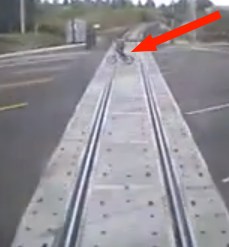
TriMet is trying to get the word out about safety when it comes to WES Commuter Rail trains and conflicts between buses and bikes. As part of a summer safety campaign that kicked off Monday, the agency has released five videos showing close calls between people crossing tracks in front of WES trains. They have also sent out a new, in-depth training bulletin to all bus drivers that is focused specifically on bicycling.
One of the videos shows a person on a bicycle crossing the path of an 80-ton WES train that’s a mere 60 feet away. According to TriMet, WES trains traveling 55 mph take about a half-mile to come to a stop. The incident with the bicycle rider happened on September 15th near SW Scholls Ferry Road in Beaverton. Here’s the video:
TriMet’s safety campaign also includes “enforcement and awareness missions” from the Transit Police Division and railroad authorities throughout the summer, “to remind people to be aware of approaching trains, obey warning devices and stay safe near the tracks.”
TriMet is also reminding folks that you could be given a citation and a $242 fine for “failure to stop for a railroad signal.”

In other TriMet safety news, today a reader emailed me a three-page TriMet document titled, Training Bulletin: Cyclist Awareness and Safety (PDF). The bulletin, that’s being sent out to all TriMet operators, is an in-depth look at cycling. It covers what behaviors bus operators should expect from people on bikes, a review of relevant traffic laws, how to deal with intersections, passing, and more.
Here’s a snip from the intro:
“Cycling is growing and will continue to grow… People cycle for pleasure and for transportation. Some cyclists belong to and ride with clubs. More and more however, people are cycling to commute to work, shopping or school… The cyclist you see every day may be a friend, neighbor, or one of your customers. They may even be a co-worker.”
Thankfully, the bulletin explains to bus operators that “cyclists are vulnerable” and that people encounter all sorts of “problems” out on the road while riding including:
- Narrow and unfriendly roadways
- Edge of the road is often in bad condition
- Debris blows to side of the road.
- Storm grates
- Potholes
- Parked cars
Here’s how the bulletin urges operators to deal with passing someone on a bike:
Passing – Be aware of your draft.
- Scan far ahead to spot cyclists early.
- Pass with at least a minimum of 4-feet of space.
- Buses push air to the sides so reduce your speed if the cyclist is moving much slower than you.
- Avoid passing unless necessary – the safest place is for them to be ahead of you.
- Pass only at wide spots, or split or change lanes to create enough space to safely pass.
- Confirm your clearances in the mirror as you pass.
And here’s the section on yielding to people in bike lanes:
Bike Lanes – Yield to cyclists
- Anytime you cross or enter a bike lane to turn, to change lanes, to park, or to make a service stop, you do not have the right of way, you must yield to cyclists.
- You may enter a bike lane to make a service stop, but yield to any approaching cyclists.
- Be aware of the potential for cyclists to appear from behind your bus when you exit a stop.
- Clearly signal your exit prior to exiting and if you moving out from the curb, use the Yield Light.
The bulletin shows an impressive amount of detail and understanding about how people ride bikes and the safety issues they present to bus operators. I think it’s safe to say that existing in America’s most bike-friendly city has had some positive impacts on TriMet management. I hope operators take the time to read it, absorb it, and then act accordingly. (And please don’t assume that last line means I don’t think people on bikes have any responsibility in this equation. They do. Obviously. Thank you.)
Download the bulletin here (PDF).


